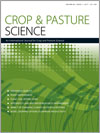CP16380Sensitivity of sensor-based nitrogen rates to selection of within-field calibration strips in winter wheat
Vegetative indices registered by active optical sensors (AOSs) are transformed into variable nitrogen (N) rate applications. Because of large spatial variation of crop N status, it is difficult to identify sample strips within fields that are most suitable for AOS calibration. This study showed that the sample-strip selection significantly affected sensor-based N prescriptions. The whole-field NDVI values collected during pesticide applications may help to select the most representative sample strips for AOS calibration.




